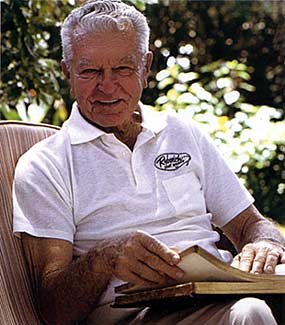JOHN RYBOVlCH JR., shown in 1989, died in 1993, but left a long legacy of innovation. Rybovich sold boats to families with such well-known names as Maytag, Firestone, Kaiser and Busch.
Pop Rybovich, meanwhile, ran the boat yard with help from his stepdaughters Ethel and Irene. Recalling postwar shortages after World War I, he collected thousands of feet of unwanted lumber: white oak for frames, mahogany for planking and trim, and teak from Burma for stern decking. When the Rybovich boys returned, Pop was ready.
While away, Tommy had been dreaming up new designs: Johnny devised a new method of wire bracing for all-metal outriggers and Emil expanded his knowledge of mechanics.
Upon their return, they teamed up on new generation of sportfishing boat. The Miss Chevy II, a 34-footer with an 11-foot beam, was commissioned by C.F. "Charlie" Johnson of Palm Beach, who owned a string of automobile agencies. Miss Chevy II was launched in 1947 at a cost or $30,000.
"They're sound," Johnson was quoted as saying. "Pop Rybovich knows wood, and the boys know how to build. Every stick is perfect."
Miss Chevy II was constructed of cedar plank, with a high-gloss finish and expanses of bright work that had never been seen on a boat meant strictly for fishing. With a flared bow and deep entry that flattened aft, she was dry, stable, and fast -— powered by a pair of 8-cylinder Chrysler engines.
Asked in 1989 if he remembered the boat, Charlie Johnson, then 92, said, "She'd sure get out and scoot." Johnson owned a total of four Rybovich boats, selling the first three in order to purchase a fourth.
"Tommy, Emil and I were just fortunate to have been born at a time when it was easy to be inventive," John Rybovich Jr. observed in 1989. "With a good idea and a couple of tools, you could make something."
The Ryboviches, never quick to claim credit for the innovations that have become synonymous with their boats, like to say they found ways to improve the ideas of others, and when faced with competition, have always looked for opportunity.
"My father and his brothers would always tell us, 'If you see a good idea on someone else's boat, grab hold of it and use it.' God knows, they copied our boats for years. Everybody did," says Michael Rybovich, Emil Rybovich's son and co-owner of Ryco Marine in Riviera Beach.
"We realized early on that we couldn?t take credit for all the innovations," says Michael Rybovich. "So many of the innovations we are credited with creating came from customer and crew requests. We have to give credit to the people out there every day, working with the boats.

"The retractable aluminum outrigger that you see on all of today's sportsfishing boats, was perfected by my uncle Johnny. The fighting chair — the so-called "Tuna Chair" — was Uncle Johnny's design. The hardware's the same. It's essentially the same product he developed in the late '40s and early '50s.
"My father and his brothers literally defined the industry that we're living off of up and down the coast. We're very proud of having been a part of that."
Coming up with a good idea and making it work has always been a family affair for the Ryboviches.
Johnny was president, overseeing company operations. Emil, when not working on systems, piloted the firm's SeaBee, a four-seat amphibian aircraft, to emergency repair jobs in the Bahamas. Tommy was the firm's designer.
"I hope when history is written," John Rybovich said in a 1989 conversation with Nautical Quarterly, "it will record the part we played in the creation of the sportfishing boat."
The company rarely advertised, yet established an international reputation, having sold boats to families with names such as Maytag, Firestone, Likes, Kaiser, Kimberly and Busch.
"When we started what we call the "modern series" in 1946, we thought a limited number of sports fishermen might be willing to pay top prices for top quality," John Rybovich told the Saturday Evening Post in 1958. "We never dreamed there would be so many customers."
"Emil and John Jr. sold the family business to Robert Fisher (Body by Fisher) in 1976. Pop Rybovich had died in 1970, having little effect on the family boat yard, but with Tommy Rybovich's death in 1972, "the creative process stopped," according to Gary Hilliard who became the yard's head boat builder under the company's third set of owners, Harvey Wilson and Mike Matlack.